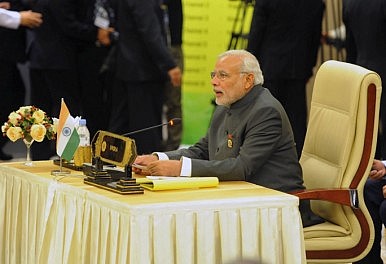By Rajeswari Pillai Rajagopalan
 Last week, Indian Prime Minister Narendra Modi was on a three-nation visit to Southeast Asia – Indonesia, Malaysia, and Singapore – in an effort to give a fillip to India’s ‘Act East’ Policy. India’s Act East Policy acquired fresh momentum when Modi re-launched the original Look East Policy at the East Asia Summit in 2014. Most recently, the leaders of the ten Association of Southeast Asian Nations (ASEAN) countries were in India for the 69th Republic Day celebrations in January 2018, a reflection of the growing strategic convergence between India and Southeast Asia in ensuring a free, open, and transparent Indo-Pacific.
Last week, Indian Prime Minister Narendra Modi was on a three-nation visit to Southeast Asia – Indonesia, Malaysia, and Singapore – in an effort to give a fillip to India’s ‘Act East’ Policy. India’s Act East Policy acquired fresh momentum when Modi re-launched the original Look East Policy at the East Asia Summit in 2014. Most recently, the leaders of the ten Association of Southeast Asian Nations (ASEAN) countries were in India for the 69th Republic Day celebrations in January 2018, a reflection of the growing strategic convergence between India and Southeast Asia in ensuring a free, open, and transparent Indo-Pacific.
Driven by the China factor, Modi’s visit to the three key states in Southeast Asia has the potential to propel greater strategic engagement especially in the maritime domain, but India’s capacity and strategic interest in playing a proactive role in the region is key. The most interesting of the three stops was Modi’s visit to Indonesia.
Indonesia remains a key player within Southeast Asia for several reasons. Most clearly, Indonesia will be essential in extending India’s maritime outreach. Indonesia is the largest archipelagic state, and has a coastline of 108,000 kilometers, 17,504 islands, and a total of maritime areas of 6,400,000 square kilometers, including its Exclusive Economic Zone (EEZ). The distance from India’s Andaman Islands to Indonesia’s Aceh province is barely 80 nautical miles, underscoring the importance to both India and Indonesia of the importance of enhanced maritime cooperation for the continuing peace, stability and economic prosperity of the Indo-Pacific region.
These make India and Indonesia two key maritime powers in the Indo-Pacific, and the two navies have partnered in naval exercises for several years now with naval ships patrolling between the Andaman Sea and Malacca Straits. But it has also become clear that is is time to deepen these engagements in the light of the changing strategic dynamics in the broader Indo-Pacific front.
Modi’s visit to Jakarta from May 29-30 witnessed extensive strategic discussions with President Joko “Jokowi” Widodo on everything from maritime issues to outer space and broader defense cooperation. According to the joint statement signed by the two leaders, the big underlying emphasis was the “importance of achieving a free, open, transparent, rules-based, peaceful, prosperous and inclusive Indo-Pacific region, where sovereignty and territorial integrity, international law, in particular UNCLOS, freedom of navigation and overflight, sustainable development and an open, free, fair and mutually beneficial trade and investment system are respected.”
Modi and Jokowi emphasized also the importance of rule of law, in particular the 1982 UN Convention on the Law of Sea (UNCLOS), clearly with China’s recent behavior in mind. Elevating the importance of Andaman Islands and increasing maritime connectivity were also emphasized during the visit.
Indonesia has also shown some interest in joining the Bay of Bengal initiative, which appears sensible both from an economic and security perspective. Given the geographical proximity of the Andaman Island with Sumatra Island to the south, Indonesia should be part of this initiative. The Lombok Strait also provides “an easy access to the Indian Ocean and Australia.”
India has also shown interest in joining the Malacca Straits Patrol (MSP), a four-nation arrangement between Indonesia, Malaysia, Singapore, and Thailand for exchange of intelligence, and coordinated air and sea patrol through the Malacca Straits. But India may have to wait a bit on this. For one, New Delhi does not appear to have paid much attention to the mechanics of how the MSP operations actually work. For instance, a meeting among technical experts on May 10 explored the issue but it is reported that “both sides quickly realised that the Indian side had not fully come to grips with the nuts and bolts of the MSP.” India expected that its navy could undertake patrols in the Malacca Straits, whereas under the MSP, each of the four countries do “coordinated patrols” within their own territorial waters and do not cross into each other’s waters.
Similarly, New Delhi also appears not to have understood how MSP aerial patrols work, assuming that Indian aircraft could patrol on their own in the region, which is not the MSP practice. New Delhi will have to prepare much more professionally in future engagements. As a political face-saver, the joint statement issued by the Modi and Jokowi simply noted that the technical experts meeting on May 10 was “to explore ways in enhancing strategic technical cooperation on maritime security.”
For another, Indonesia and others in the MSP also appear to worry about setting a precedent that China can exploit if they allow an extra-regional power such as India join the MSP. These are understandable concerns, and New Delhi and the MSP countries will have to figure out carefully how they can cooperate but at a pace and manner that is comfortable for all.
India appears to have assumed that China’s aggressive push in South China Sea would make Southeast Asian states welcome India with open arms, but New Delhi must realize they have their own concerns about antagonizing China. Nonetheless, there is an underlying commonality of strategic concerns that can be the foundation for deepening ties, even if both sides have to be careful in how they proceed. But proceed they must.
No comments:
Post a Comment